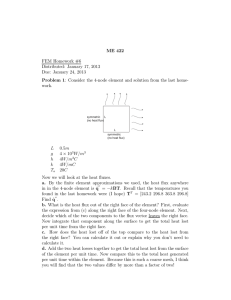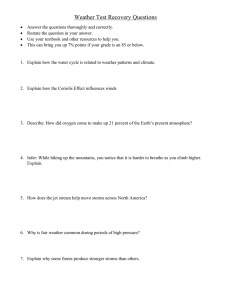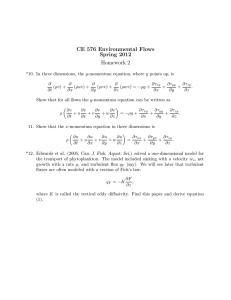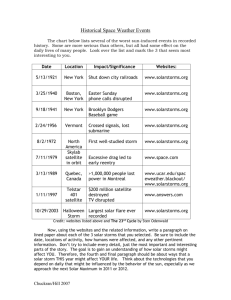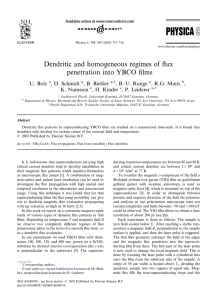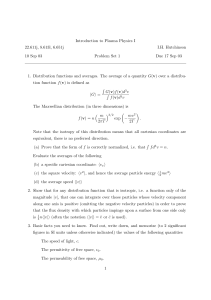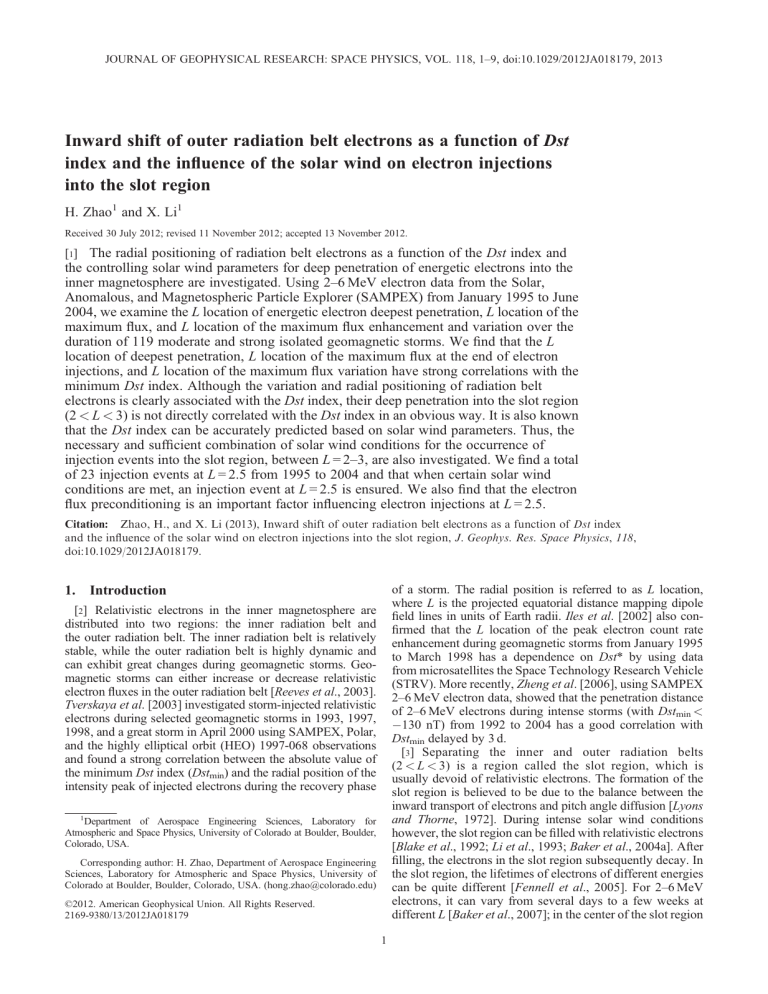
JOURNAL OF GEOPHYSICAL RESEARCH: SPACE PHYSICS, VOL. 118, 1–9, doi:10.1029/2012JA018179, 2013
Inward shift of outer radiation belt electrons as a function of Dst
index and the influence of the solar wind on electron injections
into the slot region
H. Zhao1 and X. Li1
Received 30 July 2012; revised 11 November 2012; accepted 13 November 2012.
[1] The radial positioning of radiation belt electrons as a function of the Dst index and
the controlling solar wind parameters for deep penetration of energetic electrons into the
inner magnetosphere are investigated. Using 2–6 MeV electron data from the Solar,
Anomalous, and Magnetospheric Particle Explorer (SAMPEX) from January 1995 to June
2004, we examine the L location of energetic electron deepest penetration, L location of the
maximum flux, and L location of the maximum flux enhancement and variation over the
duration of 119 moderate and strong isolated geomagnetic storms. We find that the L
location of deepest penetration, L location of the maximum flux at the end of electron
injections, and L location of the maximum flux variation have strong correlations with the
minimum Dst index. Although the variation and radial positioning of radiation belt
electrons is clearly associated with the Dst index, their deep penetration into the slot region
(2 < L < 3) is not directly correlated with the Dst index in an obvious way. It is also known
that the Dst index can be accurately predicted based on solar wind parameters. Thus, the
necessary and sufficient combination of solar wind conditions for the occurrence of
injection events into the slot region, between L = 2–3, are also investigated. We find a total
of 23 injection events at L = 2.5 from 1995 to 2004 and that when certain solar wind
conditions are met, an injection event at L = 2.5 is ensured. We also find that the electron
flux preconditioning is an important factor influencing electron injections at L = 2.5.
Citation: Zhao, H., and X. Li (2013), Inward shift of outer radiation belt electrons as a function of Dst index
and the influence of the solar wind on electron injections into the slot region, J. Geophys. Res. Space Physics, 118,
doi:10.1029/2012JA018179.
of a storm. The radial position is referred to as L location,
where L is the projected equatorial distance mapping dipole
field lines in units of Earth radii. Iles et al. [2002] also confirmed that the L location of the peak electron count rate
enhancement during geomagnetic storms from January 1995
to March 1998 has a dependence on Dst* by using data
from microsatellites the Space Technology Research Vehicle
(STRV). More recently, Zheng et al. [2006], using SAMPEX
2–6 MeV electron data, showed that the penetration distance
of 2–6 MeV electrons during intense storms (with Dstmin <
130 nT) from 1992 to 2004 has a good correlation with
Dstmin delayed by 3 d.
[3] Separating the inner and outer radiation belts
(2 < L < 3) is a region called the slot region, which is
usually devoid of relativistic electrons. The formation of the
slot region is believed to be due to the balance between the
inward transport of electrons and pitch angle diffusion [Lyons
and Thorne, 1972]. During intense solar wind conditions
however, the slot region can be filled with relativistic electrons
[Blake et al., 1992; Li et al., 1993; Baker et al., 2004a]. After
filling, the electrons in the slot region subsequently decay. In
the slot region, the lifetimes of electrons of different energies
can be quite different [Fennell et al., 2005]. For 2–6 MeV
electrons, it can vary from several days to a few weeks at
different L [Baker et al., 2007]; in the center of the slot region
1. Introduction
[2] Relativistic electrons in the inner magnetosphere are
distributed into two regions: the inner radiation belt and
the outer radiation belt. The inner radiation belt is relatively
stable, while the outer radiation belt is highly dynamic and
can exhibit great changes during geomagnetic storms. Geomagnetic storms can either increase or decrease relativistic
electron fluxes in the outer radiation belt [Reeves et al., 2003].
Tverskaya et al. [2003] investigated storm-injected relativistic
electrons during selected geomagnetic storms in 1993, 1997,
1998, and a great storm in April 2000 using SAMPEX, Polar,
and the highly elliptical orbit (HEO) 1997-068 observations
and found a strong correlation between the absolute value of
the minimum Dst index (Dstmin) and the radial position of the
intensity peak of injected electrons during the recovery phase
1
Department of Aerospace Engineering Sciences, Laboratory for
Atmospheric and Space Physics, University of Colorado at Boulder, Boulder,
Colorado, USA.
Corresponding author: H. Zhao, Department of Aerospace Engineering
Sciences, Laboratory for Atmospheric and Space Physics, University of
Colorado at Boulder, Boulder, Colorado, USA. (hong.zhao@colorado.edu)
©2012. American Geophysical Union. All Rights Reserved.
2169-9380/13/2012JA018179
1
ZHAO AND LI: L-DST DEPENDENCE AND THE SLOT REG
by at least one order of magnitude, and Lflux
max as the L on which
the flux at the end of injection is the largest. Also, we define
(by percentage/value) as the L of the maximum flux
Lincrease
max
enhancement, that is, the L on which the flux increases most by
percentage/value from the beginning of the storm to the end of
injection; Lvariation
(by percentage/value) is defined as the L of
max
the maximum flux variation, that is, the L on which the flux
increases most by percentage/value from the point of the lowest
flux during the storm to the end of injection. Figure 1 shows an
example of how to calculate the flux enhancement and variation. The dashed line marks the middle of the day of Dstmin.
We define the flux at the end of an injection as the averaged flux
2–4 d after the day of Dstmin, and this time period is indicated by
the gray block on the right of Figure 1; the flux at the beginning
of the storm is defined as the averaged flux 1–3 d before the day
of Dstmin, indicated by the gray block on the left of Figure 1.
The colored asterisks represent the lowest fluxes during the
storm at corresponding L shells. As Figure 1 shows, the lowest
fluxes during the storm at different L shells can occur at different days; at L = 2.5, the flux variation is similar in magnitude to
the flux enhancement, but at L = 4 or L = 6, the flux variations
are much larger than the flux enhancements.
[6] In this study, we broaden the size of storms and
enlarge the number of selected storms from previous studies
[e.g., Tverskaya et al., 2003] by using all moderate and
strong storms (with Dstmin < 50 nT) during 1995–2004.
To avoid the influence of multiple storms, we use only isolated storms in this study. We set the criteria for isolated
storms as the following: first, only those storms with no other
storms occurring within 7 d before or 4 d after are included;
for some strong storms, the electron flux is not likely to be
significantly influenced by much smaller storms nearby, thus
we also include those intense storms that are much larger than
other storms (with ΔDstmin > 100 nT) that happen within 7 d
before and 4 d after. Figure 2 shows an example of the storm
selection criteria. In April 2000, three storms meet our criteria, as marked with red asterisks. For storms on 16 April
and 24 April, no other storms occur within 7 d before or 4 d
after, so these two storms are included; the storm on 5 April,
marked with the green asterisk, is not counted as an isolated
storm because 2 d later another large storm occurred. The
storm on 7 April, however, is included despite being only
2 d after a storm because it is much larger than the nearby
storm. From January 1995 to June 2004, a total of 124 storms
Figure 1. An example of how to calculate the flux enhancement and the flux variation during an isolated storm based on
daily averaged 2–6 MeV electron flux data from SAMPEX.
The dashed line marks the middle of the day of Dstmin. The
fluxes averaged over the 3 d periods indicated by two gray
blocks are defined to be the flux at the beginning of the storm
(left) and the flux at the end of injection (right), respectively.
The asterisks represent the lowest fluxes during the storm at
corresponding L shells.
(L = 2.5), the lifetime of 2–6 MeV electrons is about
3.6 1.6 d [Meredith et al., 2009].
[4] In this study, we examine the relationship between different definitions of L location of 2–6 MeV electron injections
and minimum Dst during all moderate and intense isolated
storms from 1995 to 2004. The data we use are daily averaged
2–6 MeV electron flux measurements from SAMPEX, which
operates in a near-circular orbit with an altitude of 520 by
670 km and an 82 inclination [Baker et al., 1993]. The electron flux data are sorted by L shell, which corresponds to radial
distance in Earth radii at the equator by mapping magnetic
field lines, with ΔL = 0.1. By using a wide intensity range of
storms, with Dstmin from –50 nT to around –400 nT, and multiple L location definitions, we show the correlation between L
location and Dst index in more depth than previous work. We
also investigate electron flux during isolated storms at each L
shell and the sum of electron fluxes throughout the slot region
and the outer belt, and find that almost all storms show flux
enhancements at some L shell, but only about 40% of the
storms cause increases of the total electron flux between L = 2
and L = 7, 20% cause decreases, and 40% produce no change.
Additionally, using daily averaged 2–6 MeV electron flux data
and 5 min solar wind data from OMNIWeb, we perform a
survey of the relationship between 2 and 6 MeV electron
injections into the slot region and solar wind conditions, comparing the relative effectiveness of solar wind parameters and
their combinations. In addition to solar wind conditions, we
find another important factor, electron flux preconditioning,
which greatly influences the likelihood of electron injections
into the slot region.
2. Storm-Injected Relativistic Electrons
and Dst Index
[5] To investigate the relationship between the L location
of 2–6 MeV electron injections and the minimum Dst index
during geomagnetic storms, we examine daily averaged data
from SAMPEX of 2–6 MeV electrons from 1995 to 2004.
We define Llowest as the lowest L on which the flux changes
Figure 2. Selected isolated geomagnetic storms in April
2000. Three storms, marked with red asterisks, are selected
according to our criteria, while the storm with the green
asterisk is not included.
2
ZHAO AND LI: L-DST DEPENDENCE AND THE SLOT REG
Figure 3. (a) Lowest L shell on which the flux changes by at least one order of magnitude, (b) L shell on
which the flux at the end of injection is the highest, (c and d) L shell on which the flux increases the most
from the beginning of the storm to the end of injection (by percentage/ by value), (e and f) L shell on
which the flux increases the most from the lowest flux during the storm to the end of injection (by percentage/ by value), versus |Dstmin| during 117 isolated geomagnetic storms from 1995 to 2004. The correlation
coefficient of each case is shown on each panel.
stronger the storm, the further inward electrons can penetrate.
Compared to the deepest penetration and L location of the
maximum flux and flux variation, the correlation coefficients
between Lincrease
by percentage/value and |Dstmin| are not as
max
high (0.48 and 0.53, respectively). Reeves et al. [2003]
investigated relativistic electron fluxes in the outer radiation
belt during geomagnetic storms and showed that during
about half of geomagnetic storms, the flux at a given L shell
in the outer radiation belt increases, while for another half,
the electron flux either remains the same or decreases, and
that this result is independent of the specific L shell investigated. This explains the weak correlation between Lincrease
max
and Dst index. During some geomagnetic storms, especially
some moderate storms, the flux at the outer radiation belt
decreases, while at lower or even higher L the electron flux
does not change or increases slightly, thus a lower or higher
L shell would become the L shell on which the flux
“increases” the most. As indicated in Figure 3d, the magnitudes of the maximum flux enhancement during some storms
are quite low, and for these storms the L shell of the
maximum flux enhancement is usually very low or very
high. On the other hand, the L location of the maximum flux
variation during the storm does have a strong correlation
met these requirements; 10 of them were large storms with
much smaller storms nearby, and among these 10 storms
the closest smaller storm occurred about 1 d before. Excluding storms during which the SAMPEX data are not available,
a total of 119 storms are investigated; also excluding storms
during which the flux did not increase at any L shell from
L = 2 to L = 7, finally, a total of 117 storms are used in the following study.
[7] Figure 3 shows the six different L locations defined
previously versus |Dstmin| during 117 storms from 1995 to
2004. The magnitudes of the maximum flux, flux enhancement, and flux variation (by percentage/value) for each
variation
storm are also shown in Figure 3. Llowest, Lflux
max and Lmax
(by value) have the highest correlations with |Dstmin|, with
correlation coefficients of 0.78, 0.83, and 0.87, respectively.
For intense storms (Dstmin < 100 nT), the magnitudes of
the maximum flux enhancement and variation are generally
higher than for moderate storms (50 nT < Dstmin < 100 nT).
The results indicate that the location of relativistic electron
deepest penetration, location of the maximum flux at the end
of injection, and location of the highest flux variation by
value during geomagnetic storms have strong correlations
with Dst index and thus the intensity of the storm. The
3
ZHAO AND LI: L-DST DEPENDENCE AND THE SLOT REG
in geocentric solar magnetospheric coordinates, solar wind
electric field Ey, and injection events at L = 2.5 using
5 min solar wind data from OMNIWeb. During these injection events, the maximum IMF magnitude (Bmax) of each
event is greater than 24 nT; IMF Bz remains less than
–10 nT for more than 1 h; the maximum Ey (Ey max) is
larger than 8 mV/m, while 21 of 23 events occurred with
Ey max > 9 mV/m. There is also some correlation between
solar wind speed (Vsw) and injection events. During most
events (22 of 23) the maximum Vsw (Vswmax) is greater
than 500 km/s. Solar wind density and dynamic pressure,
however, show no obvious correlation with injection events.
[11] We find that the sufficient conditions for injection
events at L = 2.5 are: Bmax > 24 nT, Ey max > 9 mV/m, and
Ey * time (when Ey > 0.5 mV/m) > 7 mV/m*d. Here Ey *
time is calculated within 1.5 d before and after Eymax, and
calculated only when Ey > 0.5 mV/m, which means it only
includes the positive part of Ey. For the period 1995–2004,
there are a total of 10 intervals during which the solar wind
conditions met these sufficient conditions, and an injection
event occurred for each of these intervals.
[12] On the other hand, we wonder if there exist necessary
solar wind conditions for the injection events. The necessary
conditions we find for injection events at L = 2.5 are IMF
Bmax > 24 nT, Bz < 10 nT for at least 3 h, Ey max > 9 mV/
m, and Ey * time (when Ey > 0.5 mV/m) > 3.5 mV/m * d.
For the period 1995–2004, there are a total of 30 intervals
during which these criteria are fulfilled, and 21 of them
caused injection events at L = 2.5. There are two exceptions
during which the necessary conditions are not fulfilled. During one event, the solar wind parameters are not fully available; during the other event, the solar wind conditions are
quite mild compared to other events, and this event (on 28
March 2001) will be discussed in the next subsection. The
sufficient and necessary conditions for injection events at
L = 2.5 are summarized in Table 1.
[13] There are some research suggesting injections in the
slot region are caused by strong storms [e.g., Miyoshi and
Kataoka, 2005]. Indeed, the results we found show that most
injection events at L = 2.5 (22 of 23) occurred during intense
storms, with Dstmin < 140 nT; however, there is still one
event that happened under a moderate storm (Dstmin =
87 nT). Furthermore, intense storms do not always lead
to injection events in the slot region: there are 10 storms for
the period 1995–2004 with Dstmin < 140 nT that did not
cause injection events at L = 2.5.
3.2.2. Solar Wind Conditions and the Magnitude
of Flux Enhancements at L = 2.5
[14] We have examined the solar wind conditions associated with injection events at L = 2.5, and shown that IMF
Figure 4. The number of injection events in the slot region
from January 1995 to June 2004.
with storm intensity, as can be seen in the good correlation
and Dst index. This indicates that the flux
between Lvariation
max
variations during the storm are also greatly affected by geomagnetic activity.
[8] The results of this L-Dst study show that there is a
strong correlation between relativistic electron injections and
Dst index, not only confirming previous studies [e.g.,
Tverskaya et al., 2003] using a larger data set, but also
adding more discussions on the same topic. In the next
section, we focus on relativistic electron injections into the
slot region and their relation with solar wind parameters.
3. Relativistic Electron Injections Into the Slot
Region and Correlation With Solar Wind
Parameters
3.1. Injection Events in the Slot Region
[9] In the previous section, we showed that there is a
strong correlation between electron injections and Dst index.
In this section, we will show the relationship between electron injections into the slot region and solar wind parameters. To examine electron injections into the slot region,
we define injection events in the slot region (L = 2–3),
according to daily averaged SAMPEX 2–6 MeV electron
flux data from 1995 to 2004, as follows: at L = 2/2.1/. . ./3,
if the daily averaged 2–6 MeV electron flux increases monotonically by one order or more within 3 d, we call it an injection event at L = 2/2.1/. . ./3. From 1995 to 2004, we find, for
example, a total of 3 injection events at L = 2, 23 events at
L = 2.5, and 34 events at L = 3. Figure 4 shows the number
of injection events at L = 2-3.
3.2. Solar Wind Conditions for Electron Injections
Into the Slot Region
3.2.1. Solar Wind Conditions for Injection Events
at L = 2.5
[10] To show the correlation between solar wind parameters, including interplanetary magnetic field (IMF), and
injection events in the slot region, we choose to focus on
the center of the slot region, L = 2.5, because the electron flux
at L = 2.5 is usually the lowest within the slot region according to SAMPEX data. By examining data during 1995–2004,
we find a total of 23 injection events at L = 2.5. The results
show good correlation between IMF magnitude, IMF Bz
Table 1. The Sufficient and Necessary Solar Wind Conditions for
Injection Events at L = 2.5a
Sufficient Conditions
IMF Bmax > 24 nT
Ey max > 9 mV/m
Ey * time > 7 mV/m*d
(when Ey > 0.5 mV/m)
a
Necessary Conditions
(Except for Two Events)
IMF Bmax > 24 nT
IMF Bz < 10 nT lasting for > 3 h
Ey max > 9 mV/m
Ey * time > 3.5 mV/m*d
(when Ey > 0.5 mV/m)
The resolution of solar wind data is 5 min.
4
ZHAO AND LI: L-DST DEPENDENCE AND THE SLOT REG
2–3 d from the beginning of the event for electron flux to
reach its peak value at L = 2.5, which is also consistent with
previously published results [e.g., Zheng et al., 2006]. Here
we choose solar wind parameters during the time period of
2 d before Dst reaches its minimum and 1 d after that to investigate their correlations with the enhancement of the electron flux at L = 2.5.
[16] Figure 5 shows the relationship between solar wind
parameters and electron flux enhancements at L = 2.5 during
the 209 events from 1995 to 2004. The results show good
correlations between solar wind parameters Ey, IMF Bz, B,
and flux enhancement magnitude. The correlation coefficients of Ey max, Bz min, and Bmax with the logarithm of the flux
enhancement magnitude are 0.68, –0.64, and 0.61, respectively. Ey * time (when Ey > 0.5 mV/m) has the highest correlation coefficient with the logarithm of the flux enhancement
(0.71). On the other hand, solar wind speed, which is widely
believed to be the parameter most strongly correlated with
electron flux enhancements in the outer belt [e.g., Li et al.,
2001, 2011], has a relatively weaker correlation with flux
enhancements in the slot region (0.42). These results indicate
that solar wind parameters have good correlations with electron flux enhancements in the slot region, and solar wind electric field is the most important parameter for controlling the
magnitude of electron flux enhancements in the slot region.
3.3. Electron Flux Preconditioning for Electron
Injections Into the Slot Region
3.3.1. Electron Flux Preconditioning
[17] In section 3.2.1, we discussed sufficient and necessary solar wind conditions for injection events at L = 2.5.
We mentioned one event during which the solar wind conditions are quite mild compared to others. Figure 6 (left)
shows this event on 28 March 2001. The red dashed line
shows the beginning of this event. The most likely explanation for why this event caused an injection at L = 2.5 despite
the mild solar wind conditions is that the electron flux at L
greater than 2.5 is already high due to an intense storm on
19 March, while the flux at L = 2.5 is still low. Thus, the
steep electron flux gradient makes it easier for these electrons preexisting around L = 3 to penetrate into L = 2.5.
According to this, we define a preconditioned event as when
the 2–6 MeV electron flux at L = 3 is at least two orders
higher than the flux at L = 2.5 prior to an event. Figure 6
(right) also shows a nonpreconditioned event on 7 April
2000, which also caused an injection event at L = 2.5. Comparing these two events, we find that for the nonpreconditioned event, much more intense solar wind conditions are
required to cause a flux increase in the slot region. The minimum IMF Bz for the nonpreconditioned event on 7 April
2000 is about –30 nT, and maximum Ey is about 17 mV/m;
while for the preconditioned event on 28 March 2001, Bzmin
and Ey max are just roughly –13 nT and 8 mV/m, respectively.
Thus, electron flux preconditioning is a very important factor for electron injection into the slot region. It is worth
mentioning that the flux after the event in March 2001
is relatively lower, with a post-event flux of less than
10 electrons/s/cm2/sr/MeV. However, an electron flux enhancement of one order is quite significant at L = 2.5 and among all
other 22 injection events at L = 2.5, 9 of them have similar
post-event flux levels to this March 2001 event. Among these
nine injection events, some are caused by quite intense solar
Figure 5. IMF and solar wind parameters versus logarithm
of flux enhancement at L = 2.5 during 209 events from 1995
to 2004. Dashed lines are linear fits to the points.
and solar wind electric field have good correlations with injection events. Here we also want to examine the correlation
between the magnitude of flux enhancement at L = 2.5 and
solar wind parameters using a larger database of events.
Because the Dst index can be predicted by solar wind
parameters accurately [Temerin and Li, 2002, 2006], we
use Dst index to identify those events for convenience. We
choose to use storms with Dstmin < 50 nT during 1995–
2004, and for multiple storms happening within 2 d, we
choose the most intense one. There are a total of 209 events
that meet these criteria.
[15] We calculate the electron flux enhancement at L = 2.5
as the ratio of the flux at the end of the event to the flux at the
beginning of the event. Because now we focus only on flux
enhancements at L = 2.5, we use different definitions of the
beginning and the end of the event from section 2. The
beginning of the event here is defined to be 0 or 1 d before
Dst reaches its minimum, depending on which day the electron flux at L = 2.5 is lower, while the end of the event is
defined to be 3 d after the beginning of the event. There is a
time delay between solar wind impact and the electron flux
enhancements in the slot region and we find it usually takes
5
ZHAO AND LI: L-DST DEPENDENCE AND THE SLOT REG
Figure 6. Daily averaged 2–6 MeV electron fluxes in the slot region, IMF magnitude, IMF Bz, solar
wind electric field, solar wind speed, and Dst index on 18–30 March 2001 (left) and 1–13 April 2000
(right). Red dashed lines mark the beginning of these injection events at L = 2.5.
wind conditions and strong storms, with |Dstmin| up to 250 nT; but because the ratios of the electron flux at L = 3
to L = 2.5 before these injection events are lower than that before the preconditioned event in March 2001, the post-event
flux levels for these events are just similar to the March 2001
event, which also confirms the importance of electron flux
preconditioning.
3.3.2. Electron Flux Preconditioning of Injection
Events at L = 2–3
[18] In the previous subsection, we focused primarily on
injection events at L = 2.5. In this subsection, to investigate
the influence of electron flux preconditioning, we use all
injection events occurring in the slot region, from L = 2 to
L = 3. Based on the definition of preconditioned events
above, we divide injection events into preconditioned events
and non-preconditioned events according to the flux profile
at the beginning of the event. The definition of the beginning
of the event here is the same as the one in section 3.2.2. We
then plot the lowest L shell on which electron flux increased
by at least one order (that is, the lowest L shell on which
the injection event occurred based on our definition) versus
|Dstmin| during the injection event (Figure 7). Figure 7 shows
that for non-preconditioned events, the storm must be much
stronger than preconditioned events to cause injections in
the slot region. This suggests that with proper preconditioning, such as defined above, relativistic electrons are more
likely to be injected into the center of the slot region,
L = 2.5, while without preconditioning, it is also possible for
electrons to move inward but much larger storms and thus
much more intense solar wind conditions are required.
that SAMPEX data may have saturation issues, and there
may be some uncertainties in the L-location calculation.
However, we demonstrate here that these uncertainties do
not significantly affect the results in this L-Dst dependence
study. For each storm, we examine the uncertainty in the L
location of the maximum flux at the end of injection. Figure 8
shows the uncertainties in the L location of the maximum
flux previously examined in Figure 3b. Red lines represent
where the electron flux is greater than 90% of the maximum
flux at the end of injection. Figure 8 shows that even considering these uncertainties, the L shell of the maximum flux at
the end of injection still has a strong correlation with Dst
Figure 7. Lowest L shell on which 2–6 MeV electron flux
increased by at least one order of magnitude versus |Dstmin|
during injection events that occurred at L = 2–3. Red points
represent preconditioned events; black points represent nonpreconditioned events. The dashed line shows L = 2.5.
4. Discussion
[19] Figure 3 shows the L-Dst dependence based on 117
geomagnetic storms during 1995–2004. It is worth noting
6
ZHAO AND LI: L-DST DEPENDENCE AND THE SLOT REG
into L = 2.5, and if the ratio of electron flux at L = 3 to L = 2.5
before the event is higher, the penetration into L = 2.5 would
be easier. Among the preconditioned events, some of them
are better preconditioned than others with a higher ratio of flux
at L = 3 to L = 2.5; thus, for these events, it is much easier to
penetrate into the center of the slot region.
[23] Also, our choice to use 3 d averaged flux at the beginning of the storm and at the end of injection may have some
influence on the result of L-Dst dependence. To investigate
in more detail, we try using different definitions for prestorm flux and post-storm flux. For example, we use the flux
of the day before Dstmin as the flux at the beginning of the
storm, and use the flux of 3 d after Dstmin as the flux at the
end of injection; we also try using the maximum flux 1–3 d
before Dstmin and the maximum flux 2–4 d after Dstmin.
The results derived from these two different definitions are
nearly identical with results showed in section 2.
[24] It is worth mentioning that among all isolated storms
with Dstmin < 50 nT from 1995 to 2004, there are only
two storms during which the 2–6 MeV electron flux at the
end of the injection is lower than the flux at the beginning
of the storm at every L shell from L = 2 to L = 7, and thus
we did not include these two storms in our study. During
all other storms, the electron flux at some L shells increased
compared to pre-storm levels, although the increase may be
very slight. The results of Reeves et al. [2003] showed that
only about half of all storms produced an increase in relativistic electron flux, one quarter decreased the fluxes and one
quarter produced little change. However, they focused only
on one L shell at a time, between L = 4 and L = 7, while we
investigate the flux enhancement at each L shell from L = 2
to L = 7 during the storm. Based on our study, besides those
two storms during which the flux decreased at all L from
L = 2 to L = 7, only 17 isolated storms (14%) produced little
increase across all L shells, by a factor of less than 2. This
indicates that most isolated geomagnetic storms (84%) do
produce significant relativistic electron flux enhancements
at some L, although the L location of peak enhancement
may vary. Also, Reeves et al. [2003] suggested that the flux
increase at a fixed L shell is independent of storm size. We
find, however, that the magnitude of the maximum flux enhancement among all L shells from L = 2 to L = 7 does have
a correlation with minimum Dst index. Figure 9 shows the
magnitude of the maximum flux enhancement by percentage
versus |Dstmin| during the 117 storms investigated, and the
correlation coefficient between them is 0.52. This indicates
that although the position of peak enhancement may change,
larger storms are more likely to produce greater flux
enhancements at some L shell.
[25] On the other hand, we also sum up 2–6 MeV electron
fluxes between L = 2 and L = 7 at the beginning of the storm
and at the end of injection, respectively, and use these summations as rough estimates of the total number of electrons
throughout the slot region and the outer radiation belt, similar to Baker et al. [2004b]. We find, however, that among all
119 storms, 47 storms (~40%) caused increases in this total
electron flux, 26 storms (~20%) caused decreases, 46 storms
(~40%) produced little net change (within a factor of 2), and
that the total flux enhancement has no correlation with storm
intensity. This may be because larger storms are also more
likely to produce greater losses.
Figure 8. L shell of the maximum electron flux at the end
of injection versus |Dstmin| for 117 storms during 1995–
2004. Red lines represent where the flux is greater than
90% of the maximum flux. The dashed line is the linear fit
to the points, and the dotted line shows the equation derived
by Tverskaya [1986].
index, and thus these uncertainties do not significantly affect
the result of L-Dst dependence.
[20] The result of Figure 3 indicates that the L location of
relativistic electron injections is greatly influenced by
geomagnetic activity, confirming previous studies [e.g.,
Tverskaya, 1986, 2003]. Tverskaya [1986] investigated
the relationship between the minimum Dst index and the L
location of peak intensity of storm-injected relativistic electrons during storms and gave the following formula:
Dst
max
¼ 2:75 * 104 =L4max :
(1)
[21] The dotted line in Figure 8 shows the relationship
between Lmax and |Dst|max indicated by this equation. To
compare with this equation, we also plot the dashed line,
which is the linear fit to the points in Figure 8. It is apparent
that although both the results from Tverskaya [1986] and
our study show clear L-Dst dependence, our result shows a
deeper electron injection during storm time. Compared with
previous studies [e.g., Tverskaya, 1986, 2003], our study
gives clear criteria for storm selection and clear definition
of Lmax, which are much easier to follow and are reproducible by others. Furthermore, by using a larger database of
storms and six different definitions of Lmax, we examine
the L-Dst dependence in more detail. The results show that
besides the L location of the maximum flux, the L location
of deepest penetration, the L location of the maximum flux
enhancement, and flux variation during isolated geomagnetic storms all correlate well with the minimum Dst index.
[22] Additionally, as Figure 7 shows, the L value of the lowest penetration into the slot region for non-preconditioned
events has a clear dependence on the minimum Dst index. This
is because the L shell of the lowest penetration during a storm
has a strong correlation with the storm intensity. For the preconditioned events, there is still a dependence of the L shell
of lowest penetration on minimum Dst but it is not as clear.
This may be because when the defined electron flux precondition is fulfilled, it is easier for energetic electrons to penetrate
7
ZHAO AND LI: L-DST DEPENDENCE AND THE SLOT REG
significantly. The CIR-driven storms appear to produce less
flux enhancement; however, this is mainly due to the fact that
CIR-driven storms are relatively smaller than CME-driven
storms in terms of minimum Dst, and as Figure 9 shows,
the maximum flux enhancements among L = 2–7 are correlated with the minimum Dst index. Also, comparing the total
flux enhancement between L = 2 and L = 7, both CME- and
CIR-driven storms produced net flux increases, decreases
and little change, and there is no significant difference between them.
[28] We also investigate the relationship between flux
enhancements in the slot region and solar wind-magnetosphere
coupling. Newell et al. [2007] examined the interaction
between solar wind and the magnetosphere and found
that the function that represents the rate of magnetic flux
opened at the magnetopause correlates quite well with
multiple geomagnetic indices and some variables characterizing
magnetospheric activity. This function, which is called the
universal solar wind-magnetosphere coupling function, can
be expressed as
Figure 9. The magnitude of the maximum flux enhancement among L = 2–7 (by percentage) versus |Dstmin| during
117 isolated storms from 1995 to 2004.
[26] Our results are not contradictory with Reeves et al.
[2003], because they only focus on one L shell at a time,
while we focus on all L shells from L = 2 to L = 7. It shows
that although at a fixed L shell, about half of storms produce
no change or decreases in the relativistic electron flux,
throughout the slot region and the outer radiation belt,
almost all storms will cause a flux enhancement at some
L shell, and around 84% of them will produce significant
increases at some L shell. However, only around 40% of
storms will produce net increases in the total number of electrons throughout the slot region and the outer belt, 40% will
produce little net change, and around 20% will cause net
decreases. It should also be noted that the relativistic electron
flux data we use is only derived from the SAMPEX satellite,
while the Reeves et al. [2003] study uses multiple satellites,
including the Los Alamos National Laboratory (LANL)
space environment monitors and Polar. Also, because we
focus on multiple L shells at a time and the SAMPEX satellite
has limited differential energy measurements, it is difficult to
derive phase space density data for a large range of L, so we
look only at fluxes rather than phase space densities.
[27] We also check the difference between geomagnetic
storms driven by coronal mass ejections (CMEs) and corotating interaction regions (CIRs) in the L-Dst dependence
and the flux enhancement of energetic electrons. By using
CME- and CIR-driven storms lists from Turner et al.
[2009, and references therein], we find that among 119 isolated geomagnetic storms from January 1995 to June 2004,
there are 54 CME-driven storms and 42 CIR-driven storms.
Comparing the L-Dst dependence of CME- and CIR-driven
storms, we find that there is no significant difference between
them except that the CIR-driven storms are smaller relatively.
For electron flux enhancements from L = 2 to L = 7, the difference between CME- and CIR-driven storms is still not significant. Among 54 CME-driven storms, only 6 storms (11%)
produced little increase across all L shells by a factor of less
than 2, all other storms (89%) produced significant increase
at some L shell between L = 2 and L = 7; while among 42
CIR-driven storms, 2 storms (5%) decreased the flux at all
L shells, 7 storms (17%) produced little increase across all
L, and 33 storms (78%) increased the flux at some L shell
dΦMP
2=3
¼ v4=3 BT sin8=3 ðθc =2Þ
dt
(2)
[29] Here, dΦMP/dt represents the rate of magnetic flux
opened at the magnetopause, v represents the solar wind velocity, BT represents the interplanetary magnetic field component
perpendicular to the solar wind velocity, and θc represents the
IMF clock angle, which is given by tan(θc) = By/Bz. Figure 10
shows the relationship between this universal coupling function and the logarithm of flux enhancement at L = 2.5. We
use the same events set and method as in section 3.2.2 to calculate the electron flux enhancement at L = 2.5. The universal
coupling function is calculated by using 1 h solar wind data
from OMNIWeb, which is suggested by Newell et al.
[2007], and averaged over 3 d (same time period used in section 3.2.2 for calculation of solar wind parameters). The linear
trend in Figure 10 is quite clear, with a correlation coefficient
of 0.70. It suggests that relativistic electron flux enhancements
Figure 10. The universal solar wind-magnetosphere coupling function (averaged) versus logarithm of flux enhancement at L = 2.5 during 209 events from 1995 to 2004.
Dashed line is the linear fit to the points.
8
ZHAO AND LI: L-DST DEPENDENCE AND THE SLOT REG
[31] Acknowledgments. We would like to acknowledge helpful discussions with Lauren Blum, Quintin Schiller, Theodore Sarris, Richard
Selesnick, and Michael Temerin, and thank Lauren Blum for careful proofreading of the manuscript. We thank the SAMPEX team and the OMNI
group at NASA/Goddard Space Flight Center for making the data available.
This work was supported by NASA grant (NNX09AF47G) and NSF grants
(CISM, ATM-0842388).
in the slot region are greatly influenced by solar wind-magnetosphere coupling and energy transfer.
5. Conclusion
[30] We have examined the relationship between Dst index and the L location of 2–6 MeV electron deepest penetration, maximum electron flux, maximum flux enhancement,
and maximum flux variation during 119 moderate and strong
isolated geomagnetic storms from 1995 to 2004 using daily
averaged 2–6 MeV electron flux data from SAMPEX. Also,
we have defined injection events in the slot region and investigated the correlation between electron injections at L = 2.5
and solar wind parameters. Moreover, we have found that
electron flux preconditioning is also an important factor for
injections in the slot region. The results are summarized as
follows:
References
Baker, D. N., et al. (1993), An overview of the SAMPEX mission, IEEE
Trans. Geosci. Electr., 31, 531.
Baker, D. N., S. G. Kanekal, X. Li, S. P. Monk, J. Goldstein, and J. L. Burch
(2004a), An extreme distortion of the Van Allen belt arising from the
’Hallowe’en’ solar storm in 2003, Nature, 432, 878–881.
Baker, D. N., S. G. Kanekal, and J. B. Blake (2004b), Characterizing the
Earth’s outer Van Allen zone using a radiation belt content index, Space
Weather, 2, S02003, doi:10.1029/2003SW000026.
Baker, D. N., S. G. Kanekal, R. B. Home, N. P. Meredith, and S. A. Glauert
(2007), Low-altitude measurements of 2–6 MeV electron trapping lifetimes at 1.5 ≤ L ≤ 2.5, Geophys. Res. Lett., 34, L20110, doi:10.1029/
2007GL031007.
Blake, J. B., W. A. Kolasinski, R. W. Fillius, and E. G. Mullen (1992),
Injection of electrons and protons of tens of MeV into L < 3 on 24 March
1991, Geophys. Res. Lett., 19, 821.
Fennell, J. F., J. B. Blake, R. Friedel, and S. Kanekal (2005), The
energetic electron response to magnetic storms: HEO satellite observations. in Physics and Modeling of the Inner Magnetosphere, AGU
monograph 115, 87.
Iles, R. H. A., A. N. Fazakerley, A. D. Johnstone, N. P. Meredith, and
P. Bühler (2002), The relativistic electron response in the outer radiation
belt during magnetic storms, Ann. Geophysicae, 20, 957–965.
Lyons, L. R., and R. M. Thorne (1972), Pitch-angle diffusion of radiation
belt electrons within the plasmasphere, J. Geophys. Res., 77(19), 3455–3474.
Li, X., I. Roth, M. Temerin, J. Wygant, M. K. Hudson, and J. B. Blake
(1993), Simulation of the prompt energization and transport of radiation
belt particles during the March 24, 1991 SSC, Geophys. Res. Lett., 20,
2423–2426.
Li, X., M. Temerin, D. N. Baker, G. D. Reeves, and D. Larson (2001),
Quantitative prediction of radiation belt electrons at geostationary orbit
based on solar wind measurements, Geophys. Res. Lett., 28(9), 1887–
1890.
Li, X., M. Temerin, D. N. Baker, and G. D. Reeves (2011), Behavior of
MeV electrons at geosynchronous orbit during last two solar cycles,
J. Geophys. Res., 116, A11207, doi:10.1029/2011JA016934.
Meredith, N. P., R. B. Home, S. A. Glauert, D. N. Baker, S. G. Kanekal, and
J. M. Albert (2009), Relativistic electron loss timescales in the slot region,
J. Geophys. Res., 114, A03222, doi:10.1029/2008JA013889.
Miyoshi, Y., and R. Kataoka (2005), Ring current ions and radiation belt
electrons during geomagnetic storms driven by coronal mass ejections
and corotatiing interaction regions, Geophys. Res. Lett., 32, L21105,
doi:10.1029/2005GL024590.
Newell, P. T., T. Sotirelis, K. Liou, C.-I. Meng, and F. J. Rich (2007), A nearly
universal solar wind-magnetosphere coupling function inferred from 10 magnetospheric state variables, J. Geophys. Res., 112, A01206, doi:10.1029/
2006JA012015.
Reeves, G. D., K. L. McAdams, R. H. W. Friedel, and T. P. O’Brien (2003),
Acceleration and loss of relativistic electrons during geomagnetic storms,
Geophys. Res. Lett., 30(10), 1529, doi:10.1029/2002GL016513.
Temerin, M., and X. Li (2002), A new model for the prediction of Dst on the
basis of the solar wind, J. Geophys. Res., 107(A12), 1472, doi:10.1029/
2001JA007532.
Temerin, M., and X. Li (2006), Dst model for 1995–2002, J. Geophys. Res.,
111, A04221, doi:10.1029/2005JA011257.
Turner, N. E., W. D. Cramer, S. K. Earles, and B. A. Emery (2009), Geoefficiency and energy partitioning in CIR-driven and CME-driven storms,
J. Atmos. Solar-Terr. Phys., 71, 1023–1031.
Tverskaya, L. V. (1986), On the boundary of electron injection into the
magnetosphere. Geomagn. Aeron., 26(5), 864–865.
Tverskaya, L. V., N. N. Pavlov, J. B. Blake, R. S. Selesnick, and J. F. Fennell
(2003), Predicting the L-position of the storm-injected relativistic electron
belt, Adv. Space Res., 31(4), 1039–1044.
Zheng, Y., A. T. Y. Lui, X. Li, and M.-C. Fok (2006), Characteristics of
2–6 MeV electrons in the slot region and inner radiation belt, J. Geophys.
Res., 111, A10204, doi:10.1029/2006JA011748.
1. The L location of deepest penetration, the L location of
the maximum flux at the end of injection, and the L location of the maximum flux variation (by value) during the
storm have strong correlations with minimum Dst index
during isolated geomagnetic storms, with correlation
coefficients of 0.78, 0.83, and 0.87, respectively.
2. From 1995 to 2004, only two isolated storms produced
2–6 MeV electron flux decreases at all L shells from
L = 2 to L = 7, and 17 storms (14%) produced little increase
in electron flux at any L shell. Most isolated storms (84%)
produced significant increases in 2–6 MeV electron flux
at some L shell, and the magnitude of the maximum flux
enhancement during the storm is correlated with the storm
size. However, the sum of fluxes throughout the slot region
and the outer belt, a rough measurement of the total number of electrons, increased during around 40% of storms,
decreased during around 20% of storms, and did not
change much during the other 40%. Moreover, the total
flux enhancement has no correlation with storm size.
3. During 1995–2004, according to SAMPEX 2–6 MeV
electron flux data, there are a total of 23 injection events
during which the electron flux at L = 2.5 increases by at
least one order of magnitude within 3 d. IMF magnitude,
IMF Bz, solar wind electric field, and solar wind speed
are correlated with injection events. The solar wind electric field and Ey * time (when Ey > 0.5 mV/m) are the most
effective parameters for injections into the slot region.
4. By examining injection events at L = 2.5, we find the sufficient and necessary solar wind conditions to cause injection
events, as shown in Table 1. For the period 1995–2004,
there are a total of 10 intervals during which the sufficient
conditions are fulfilled and injection events occurred for
each interval; a total of 30 intervals exist during which the
necessary conditions are met, and 21 of these caused injection events at L = 2.5.
5. Injection events in the slot region are not only caused by
extreme solar wind conditions; for events meeting defined
electron flux preconditioning, it is much easier for electrons to penetrate into the center of the slot region
(L = 2.5). Under the defined preconditioning, injections
into the slot region can be caused by relatively mild solar
wind condition.
9

